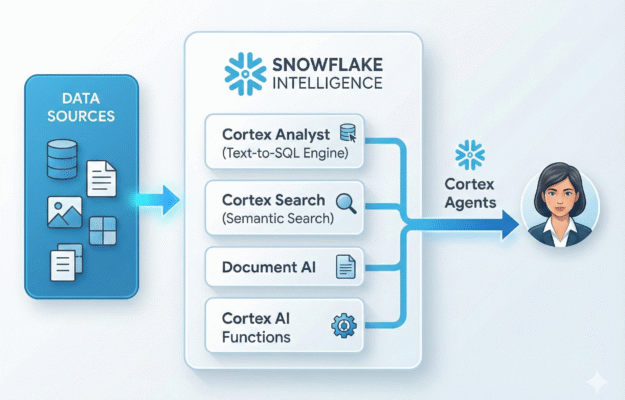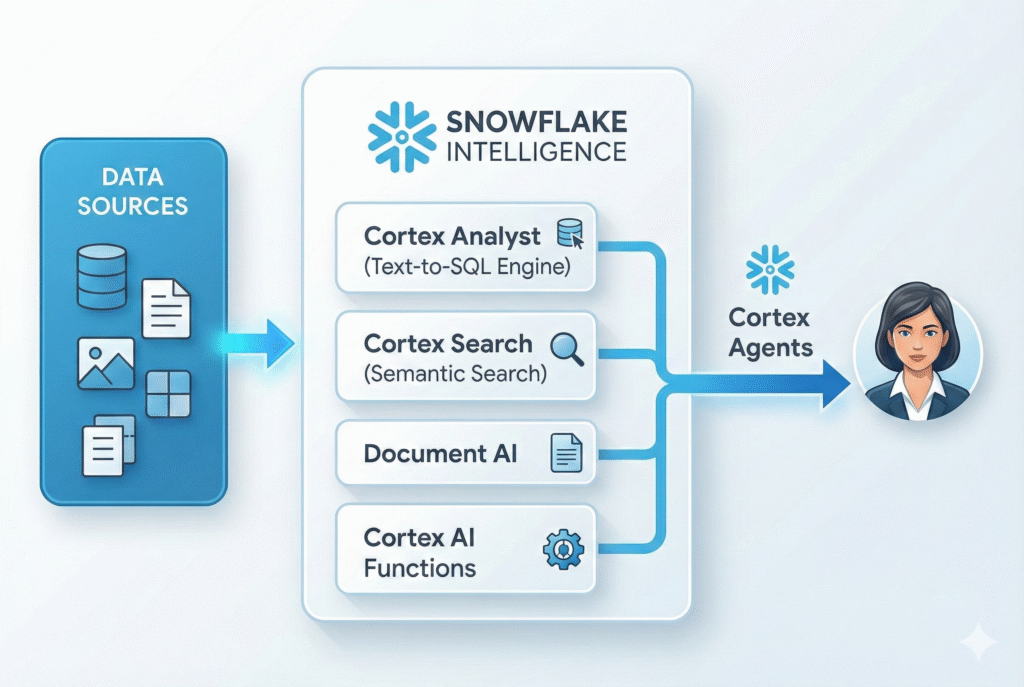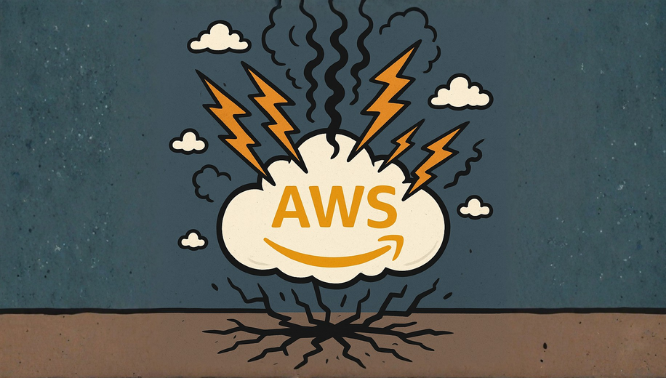Snowflake Intelligence: Transform Your Data into Actionable Insights with AI Agents


Snowflake has just launched Snowflake Intelligence, marking a fundamental shift in how organizations interact with their data. Released as Generally Available in November 2025, this groundbreaking platform enables every employee – from executives to analysts – to have conversational interactions with all enterprise data, both structured and unstructured, without writing a single line of SQL.
Think of it as having a private, enterprise-grade ChatGPT that knows everything about your data, respects your security policies, and never shares your information outside your organization’s security perimeter.
What is Snowflake Intelligence?
Snowflake Intelligence is an enterprise intelligence agent that puts insights at every user’s fingertips through natural language conversations. Unlike traditional BI tools that require technical expertise to build dashboards and reports, Snowflake Intelligence allows anyone to ask questions and receive verified, accurate answers in seconds.
Key Capabilities:
- Deep Analysis in Natural Language – Ask complex questions about your data without SQL knowledge
- Transparent & Verified Answers – Every answer traces back to its source, whether SQL queries or specific documents
- Enterprise-Ready Security – Built on Snowflake’s security framework with automatic enforcement of all governance controls
- Unified Data Access – Query structured data, documents, spreadsheets, images, and databases simultaneously
The Architecture: How Snowflake Intelligence Works
Snowflake Intelligence isn’t a single service – it’s an ecosystem of AI capabilities working together seamlessly. Understanding this architecture helps data teams implement and optimize their AI strategy.
The Core Components:
1. Cortex Agents (The Orchestrator)
Cortex Agents are the intelligent orchestration layer that plans and executes complex tasks. When you ask a question, the agent:
- Breaks down your request into subtasks
- Routes each part to the correct tool (Analyst for structured data, Search for documents)
- Reflects on results and iterates if needed
- Delivers a unified, coherent answer
2. Cortex Analyst (Text-to-SQL Engine)
This is your SQL translator. Cortex Analyst converts natural language questions into SQL queries against your structured data. It uses semantic models to understand your business context and generate highly accurate queries.
Example:
- You ask: “What were our top 3 products by revenue last quarter?”
- Analyst generates:
SELECT product_name, SUM(revenue) as total_revenue
FROM sales
WHERE sale_date >= ‘2025-07-01’ AND sale_date < ‘2025-10-01’
GROUP BY product_name
ORDER BY total_revenue DESC
LIMIT 3;
3. Cortex Search (Semantic Search)
Cortex Search provides hybrid search (vector + keyword) over unstructured data – PDFs, images, documents, and text. It automatically embeds your content into vector space for fast, accurate retrieval.
Use Cases:
- Searching through product documentation
- Finding relevant customer support tickets
- Analyzing contract clauses across thousands of legal documents
4. Document AI
Powered by Snowflake’s Arctic-TILT language model, Document AI extracts structured information from complex documents – including tables, graphics, and handwritten notes. It provides zero-shot extraction, meaning it understands documents it’s never seen before.
5. Cortex AI Functions
SQL functions for text and image analysis, including:
- AI_COMPLETE() – Generate text completions
- AI_CLASSIFY() – Categorize content
- AI_EXTRACT() – Extract structured data from text
- AI_SENTIMENT() – Analyze sentiment
- AI_SUMMARIZE_AGG() – Aggregate summaries across rows
Real-World Use Cases: Snowflake Intelligence in Action
Marketing Analytics
Question: “Which market segment is showing the highest attrition and why?”
Snowflake Intelligence:
- Queries structured sales data to identify high-attrition segments
- Searches through customer feedback documents for common themes
- Correlates the data to reveal actionable insights
- Presents findings with visualizations and sources
Result: Deep insights that would have taken days to compile, delivered in seconds.
Sales Enablement
A global enterprise built an AI-powered sales assistant using Snowflake Intelligence that answers questions by pulling from:
- Sales enablement tools
- Documentation sites
- 800+ customer success stories
Impact: Sales teams get instant, accurate answers without digging through scattered resources.
Financial Analysis
Question: “Show me the daily cumulative expenses in 2023 November”
Intelligence automatically:
- Generates the SQL query
- Executes against your data warehouse
- Presents results as interactive charts
- Allows you to drill down and explore patterns
The Seemore Data Perspective: Managing Cortex AI Costs
While Snowflake Intelligence delivers transformative capabilities, it introduces new cost management challenges. Unlike traditional warehouse costs based on compute time, Cortex AI operates on a token-based pricing model that can be difficult to predict and monitor.
The Cost Reality:
One company processed 1.18 billion records with Cortex Functions and paid nearly $5,000 for a single query. The culprit? Token consumption, not compute costs.
Key Cost Considerations:
- Token-Based Billing
- Input tokens (your questions and data) + Output tokens (AI responses)
- Roughly 4 characters = 1 token
- Processing 1 million customer reviews could consume 600M tokens
- Cortex Search “Idle Tax” Cortex Search charges for the serving layer even when not executing queries. A 50GB knowledge base with embeddings can cost $140/month in serving compute alone.
- Model Selection Matters
- Simple tasks (sentiment analysis) → Use smaller models like mistral-7b
- Complex reasoning → Reserve expensive models like claude-3-7-sonnet
Cost Optimization Best Practices:
- Monitor Token Consumption Daily – Build custom alerts since Snowflake doesn’t provide native resource monitors for AI services
- Suspend Idle Services – Especially in dev/test environments
- Implement Pre-Processing – Filter and chunk data before sending to AI functions
- Choose Right-Sized Models – Don’t use a sledgehammer when a hammer will do
- Set Realistic Refresh Rates – For Cortex Search, don’t refresh indexes more frequently than business requirements demand
For comprehensive insights on managing Snowflake Cortex AI costs, read The Hidden Cost of Snowflake Cortex AI.
Getting Started: Implementing Snowflake Intelligence
Step 1: Prepare Your Data Foundation
Before launching Snowflake Intelligence, ensure you have:
- Structured data loaded into Snowflake tables
- Semantic models created using Cortex Analyst wizard
- Documents processed through Document AI
- Cortex Search Services configured for unstructured content
Step 2: Create Your First Agent
Using the intuitive UI at Snowflake Intelligence: https://ai.snowflake.com:
- Define the agent’s purpose and context
- Connect semantic models (for structured data)
- Link Cortex Search services (for documents)
- Configure custom tools if needed
- Set up role-based access control
Step 3: Test and Iterate
Start with a pilot group:
- Test with real business questions
- Gather feedback on accuracy
- Refine semantic models based on usage patterns
- Monitor costs and adjust models accordingly
Step 4: Scale Across the Organization
Once validated:
- Roll out to broader user groups
- Create specialized agents for different departments
- Implement monitoring and governance
- Train users on best practices
The Competitive Advantage: Why This Matters Now
Early adopters are already seeing impressive ROI. Companies implementing enterprise AI report averaging 41% ROI from AI initiatives, with successful projects reaching production in months rather than years.
The Business Impact:
Speed: Questions that took days now get answered in seconds Accessibility: Business users don’t wait for data teams to build custom reports Insight Depth: AI uncovers correlations humans might miss Cost Efficiency: Reduction in manual data analysis work Decision Quality: Faster access to verified insights improves decision-making
The Data Team Impact:
Instead of being overwhelmed with ad-hoc data requests, data engineers can focus on:
- Building robust data pipelines
- Optimizing warehouse performance
- Ensuring data quality and governance
- Strategic initiatives that drive business value
Security and Governance: Enterprise-Grade Protection
One of Snowflake Intelligence’s most compelling features is its security model. Unlike external AI services where you must export data:
✅ Data Never Leaves Snowflake – Everything runs within your security perimeter
✅ No Model Training on Your Data – Customer data is never used to train public models
✅ Automatic Access Control – Queries execute with user privileges, honoring row-access policies, column masking, and data classification
✅ Full Audit Trail – Every query and answer is traceable and logged
✅ Role-Based Access – Leverage existing RBAC infrastructure
What’s Next: The Future of Enterprise Intelligence
Snowflake is rapidly expanding Intelligence capabilities:
- Web Search Integration – Allow agents to call external web sources
• Custom Actions – Invoke APIs, run code, send emails, update CRM records
• Shared Workspaces – Collaborative spaces where teams can share insights
• Advanced Charting – More flexible visualization options
• MCP Agents – Leverage Model Context Protocol for broader tool integration
• Deep Analytics – Run multiple queries to answer complex “why” questions
Conclusion: Your Next Steps
Snowflake Intelligence represents more than a technology upgrade – it’s a fundamental shift in how organizations democratize data access and decision-making. By combining the power of AI with enterprise-grade security and governance, Snowflake has created a platform that makes sophisticated data analysis accessible to everyone.
Take Action Today:
- Audit Your Current AI Readiness – Do you have structured semantic models ready?
- Identify High-Value Use Cases – Which business questions take longest to answer today?
- Start Small – Pilot with one department before rolling out enterprise-wide
- Monitor Costs – Implement token consumption tracking from day one
- Train Your Teams – Ensure both technical and business users understand best practices







